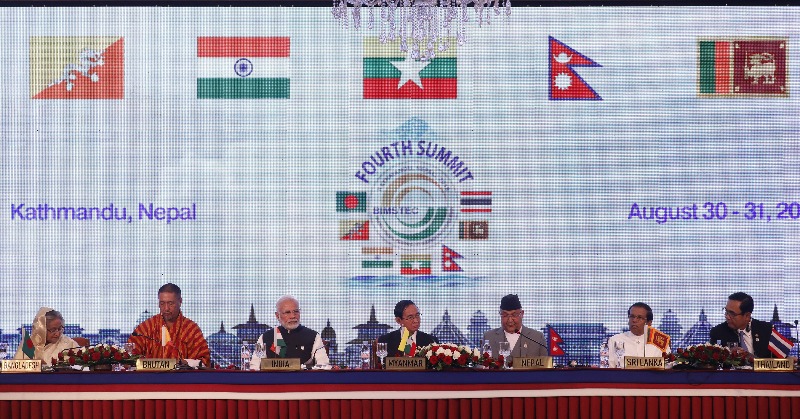December 8th is commemorated as SAARC Charter Day, but it is no hidden truth that it has failed to achieve its objectives. Regional instruments such as the Bay of Bengal Initiative for Multi-Sectoral, Technical, and Economic Cooperation (BIMSTEC) hold the key for the future.
Jump To
![]()
What is BIMSTEC?
A multilateral regional organisation called the Bay of Bengal Initiative for Multi-Sectoral Technical and Economic Cooperation (BIMSTEC) was founded with the objective of fostering shared growth and cooperation between littoral and neighbouring countries in the Bay of Bengal region.

AFP/Representational Image
It has seven total members: two from Southeast Asia, including Myanmar and Thailand, and five from South Asia, including Bangladesh, Bhutan, India, Nepal, and Sri Lanka.
With the adoption of the Bangkok Declaration in June 1997, it was established as BIST-EC with Bangladesh, India, Sri Lanka, and Thailand as members. With the entry of Myanmar in late 1997, it became BIMST-EC (Bangladesh, India, Myanmar, Sri Lanka, and Thailand Economic Cooperation), and eventually, it was named in its current form, when Nepal and Bhutan became members in 2004.
According to the official website of BIMSTEC, “the regional group constitutes a bridge between South and South East Asia and represents a reinforcement of relations among these countries.”
What is BIMSTEC’s modus operandi?
The BIMSTEC Charter, which was adopted this time around in the form of a formal document, was something that BIMSTEC lacked prior to the current summit.
It did, however, have a system in place for setting operational and policy objectives. Two different types of meetings would be used to make policy: summits, which should be held every two years, and ministerial gatherings of the foreign and commerce ministers of member nations, which should be held once a year to make decisions on trade and economic matters. Senior officials are also expected to convene a functional meeting twice a year to oversee the group’s operations.

AFP/Representational Image
The policy-making meetings for BIMSTEC have not been held as scheduled since the organisation’s inception. In the past 25 years, only five summits have been held, including this one. The Senior Officials meeting was postponed seven times between 2014 and 2017 while 18 ministerial meetings have already been held.
Before 2011 and 2014, when the secretariat was established in Dhaka and its first Secretary General, Sri Lankan diplomat Sumith Nakandala, was appointed, BIMSTEC didn’t have an official headquarters or secretariat.
SAARC vs BIMSTEC
The fact that BIMSTEC is a sector-driven organisation sets it apart from other regional organisations like SAARC or ASEAN. This implies that the members share the objectives or areas of cooperation. For instance, India was given responsibility for areas like transportation, tourism, and counterterrorism early on out of the diverse sectors like trade, energy, transport, fishery, security, culture, and tourism.
The Ministry of External Affairs claimed that, in contrast to the earlier division of 14 sectors, members of the current summit decided to completely reorganise cooperation activities into seven pillars. Additionally, it was stated that India would serve as the security pillar of the BIMSTEC, which would encompass disaster management, energy, and the fight against terrorism and transnational crime (CTTCC).
After the 2016 Uri attack, when India was able to convince SAARC (South Asian Association for Regional Cooperation) countries to boycott the organisations’ summit, which was scheduled to take place in Islamabad, Pakistan, the idea of BIMSTEC also gained popularity. Due to Indo-Pak relations and what experts refer to as Pakistan’s obstructionist approach to the organisation, SAARC’s development has slowed over time. As an alternative platform for collaboration, BIMSTEC has emerged. In an indirect reference to Pakistan, Prime Minister Modi called for increased connectivity and shared infrastructure at the 2014 SAARC summit, saying: “Those who want to come with us, welcome; those who do not, the rest of us will continue.”

AFP/Representational Image
Challenges and setbacks
Foreign policy researchers claim that BIMSTEC’s lack of effectiveness and “sluggish” pace of progress is its first and biggest problem. It was previously mentioned that operational and policy-making meetings weren’t always held at the same time. Inadequate financial and human resources are provided to the BIMSTEC secretariat for its operational tasks. India’s selective interest in BIMSTEC each time SAARC is constrained by Pakistan is another point of criticism.
Additionally, there is a lot of ground for BIMSTEC members to make up in terms of connectivity and transborder trade.

AFP/Representational Image
BIMSTEC members are parties to numerous bilateral and multilateral free trade, preferential trade, and economic cooperation agreements with other nations despite the fact that they have not yet ratified a free trade agreement.
The development of BIMSTEC has also been highlighted recently by the relationship between Bangladesh and Myanmar in light of the Rohingya refugee crisis, the border dispute between India and Nepal, and most recently, the political climate in Myanmar following the military junta’s takeover in February of last year. The fact that Myanmar’s foreign minister attended this year’s summit helped draw attention to it, as the nation is regarded as one of the top violators of human rights in the world.

